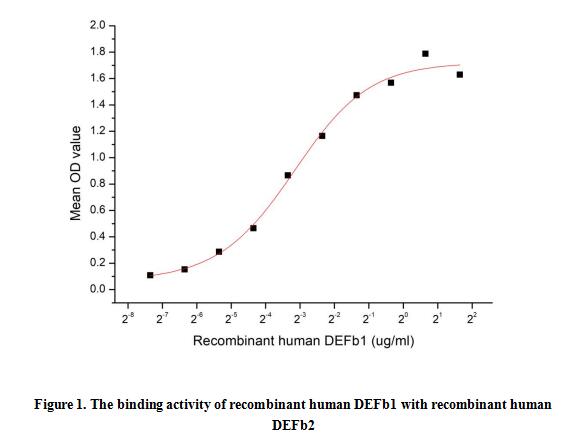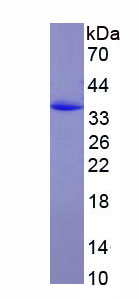Active Defensin Beta 1 (DEFb1) 

B-DF1; DEFB1; BD1; DEF-B1; DEFB101; HBD1
- UOM
- FOB US$ 324.00 US$ 810.00 US$ 1,620.00 US$ 4,860.00 US$ 12,150.00
- Quantity
Overview
Properties
- Product No.APB373Hu01
- Organism SpeciesHomo sapiens (Human) Same name, Different species.
- ApplicationsCell culture; Activity Assays.
Research use only - DownloadInstruction Manual
- CategoryInfection immunityHepatology
- Buffer FormulationPBS, pH7.4, containing 0.01% SKL, 5% Trehalose.
- Traits Freeze-dried powder, Purity > 95%
- Isoelectric Point7.6
Sign into your account
Share a new citation as an author
Upload your experimental result
Review

Contact us
Please fill in the blank.
Activity test

Beta Defensin-1 (DEFB1) displays potent microcidal properties, and also plays a part in other aspects of innate and adaptive immunity. DEFB1 genetic variations have been reported as contributing to hBD1 production impairment, leading to a greater susceptibility to be infected by oral pathogens, also leading to periodontitis. To counteract host immunity, cryptosporidium parvum has evolved multiple strategies to suppress host antimicrobial defense. One such strategy is to reduce the production of the antimicrobial peptide beta-defensin 1 (DEFB1) by host epithelial cells. Beta-Defensin-1, an antimicrobial peptide encoded by the DEFB1 gene, is known to play an important role in lung mucosal immunity. It is reported that DEFb2 has been identified as an interactor of DEFb1, thus a binding ELISA assay was conducted to detect the interaction of recombinant human DEFb1 and recombinant human DEFb2. Briefly, DEFb2 was diluted serially in PBS with 0.01% BSA (pH 7.4). Duplicate samples of 100 μl were then transferred to DEFb1-coated microtiter wells and incubated for 1h at 37℃. Wells were washed with PBST and incubated for 1h with anti-DEFb2 pAb, then aspirated and washed 3 times. After incubation with HRP labelled secondary antibody for 1h at 37℃, wells were aspirated and washed 5 times. With the addition of substrate solution, wells were incubated 15-25 minutes at 37℃. Finally, add 50 µL stop solution to the wells and read at 450/630nm immediately. The binding activity of DEFb1 and DEFb2 was shown in Figure 1. When recombinant human DEFb1 is lmmobilized at 2 ug/mL (100 uL/well), the concentration of rhDEFb2 that produces 50% optimal binding response is found to be approximately 0.11 ug/mL.
Usage
Reconstitute in 10mM PBS (pH7.4) to a concentration of 0.1-1.0 mg/mL. Do not vortex.
Storage
Avoid repeated freeze/thaw cycles. Store at 2-8°C for one month. Aliquot and store at -80°C for 12 months.
Stability
The thermal stability is described by the loss rate. The loss rate was determined by accelerated thermal degradation test, that is, incubate the protein at 37°C for 48h, and no obvious degradation and precipitation were observed. The loss rate is less than 5% within the expiration date under appropriate storage condition.
Increment services
-
 BCA Protein Quantification Kit
BCA Protein Quantification Kit
-
 Molecular Mass Marker for Protein
Molecular Mass Marker for Protein
-
 Monoclonal Antibody Customized Service
Monoclonal Antibody Customized Service
-
 Polyclonal Antibody Customized Service
Polyclonal Antibody Customized Service
-
 Protein Activity Test Experiment Service
Protein Activity Test Experiment Service
-
 Electrophoretic Mobility Shift Assay (EMSA) Experiment Service
Electrophoretic Mobility Shift Assay (EMSA) Experiment Service
-
 Buffer
Buffer
-
 Lentivirus Packaging Experiment Service
Lentivirus Packaging Experiment Service
-
 Adenovirus Packaging Experiment Service
Adenovirus Packaging Experiment Service
-
 Real Time PCR Experimental Service
Real Time PCR Experimental Service
-
 Spike RBD Protein (S-RBD)
Spike RBD Protein (S-RBD)
-
 Protein G
Protein G
-
 Protein A
Protein A
Citations
- Modulation of Porcine β-Defensins 1 and 2 upon Individual and Combined Fusarium Toxin Exposure in a Swine Jejunal Epithelial Cell LineAsm: Source
- Identification of sociodemographic and clinical factors associated with the levels of human β-defensin-1 and human β-defensin-2 in the human milk of Han ChinesePubmed: 24124699
- Concentration characteristics of bovine β-defensin 1 and 2 in fresh bovine milk and infant formulaDoi: 10.1111
- Green tea polyphenol epigallocatechin-3-gallate improves epithelial barrier function by inducing the productionof antimicrobial peptide pBD-1 and pBD-2 in monolayers of porcine intestinal epithelial IPEC-J2 cells.Pubmed:26991948
- Swine-Derived Probiotic Lactobacillus plantarum Inhibits Growth and Adhesion of Enterotoxigenic Escherichia coli and Mediates Host DefensePubmed:29997590
- Caprylic acid and nonanoic acid upregulate endogenous host defense peptides to enhance intestinal epithelial immunological barrier function via histone deacetylase …Pubmed: 30342347
- EFFECT OF NIOSOMAL ANTIMICROBIAL PEPTIDE HBD-1 ON THE HEALING RATE OF INFECTED WOUNDS IN RATS
- Effect of antimicrobial peptides HNP‐1 and hBD‐1 on Staphylococcus aureus strains in vitro and in vivoPubmed: 31313350
- Levels of pro-and anti-inflammatory cytokines in cystic fibrosis patients with or without gingivitisPubmed: 31927460
- Fat Encapsulation Reduces Diarrhea in Piglets Partially by Repairing the Intestinal Barrier and Improving Fatty Acid Transport33375218
- Human beta defensin levels and vaginal microbiome composition in post-menopausal women diagnosed with lichen sclerosus34362937
- Isolation, culture, and identification of ceruminous gland cellsPubmed:35113280







